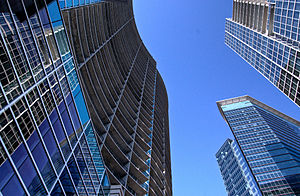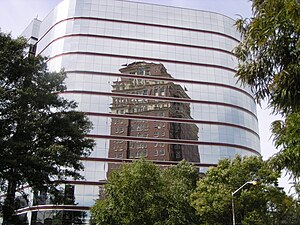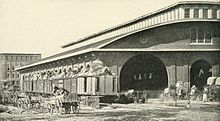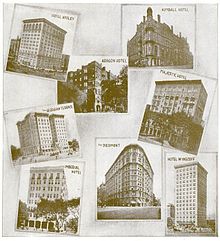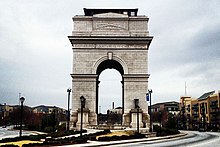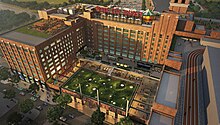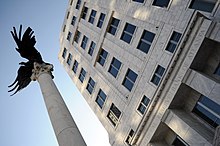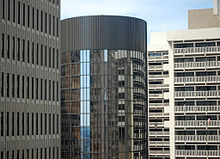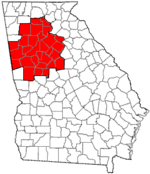
Bank of America Plaza is a supertall skyscraper between Midtown Atlanta and Downtown Atlanta. At 311.8 m (1,023 ft), the tower is the 125th-tallest building in the world. It is the 23rd tallest building in the U.S., the tallest building in the Southeastern region of the United States, and the tallest building in any U.S. state capital, overtaking the 250 m (820 ft), 50-story One Atlantic Center in height, which held the record as Georgia's tallest building. It has 55 stories of office space and was completed in 1992, when it was called NationsBank Plaza. Originally intended to be the headquarters for Citizens & Southern National Bank, it became NationsBank's property following its formation in the 1991 hostile takeover of C&S/Sovran by NCNB.
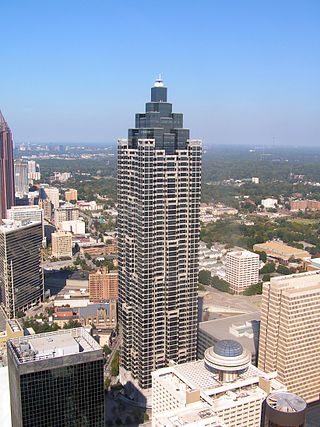
Truist Plaza is a 265 m (869 ft) 60 story skyscraper in downtown Atlanta. It was designed by John C. Portman, Jr. of John Portman & Associates and built from 1989 to 1992. In the mid-1990s, Portman sold half of his interest in the building to SunTrust Banks, which then moved its headquarters to the building and prompted a name change from One Peachtree Center to SunTrust Plaza. In 2021 the building changed its name to Truist Plaza, following a merger between SunTrust Banks and BB&T. The building is also known as 303 Peachtree. The building has a roof height of 871 feet and stands a total of 902 feet tall, including its antenna. When completed, Truist Plaza stood as the world's 28th tallest building and 21st tallest building in the United States. Now it is not in the top 400 in the world, and it is currently the 55th tallest building in the United States and 2nd tallest building in Atlanta.
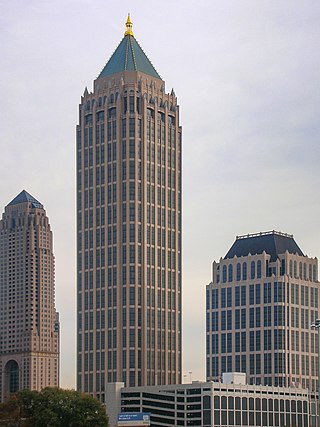
One Atlantic Center, also known as IBM Tower, is a skyscraper located in Midtown Atlanta, Georgia. It is the third tallest building in Atlanta.

One Ninety One Peachtree Tower is a 235 m (771 ft) 50-story skyscraper in Atlanta, Georgia. Designed by Johnson/Burgee Architects and Kendall/Heaton Associates Inc, the building was completed in 1990 and is the fourth tallest in the city, winning the BOMA Building of the Year Awards the next year, repeating in 1998 and 2003.

The Westin Peachtree Plaza, Atlanta, is a skyscraper hotel on Peachtree Street in downtown Atlanta, Georgia, adjacent to the Peachtree Center complex and the former Davison's/Macy's flagship store with 1,073 rooms. At 723.0 ft (220.37 m) and 73 stories, a total building area of 1,196,240 sq ft (111,134 m2) and a 187 ft (57 m) diameter, the tower is the fourth-tallest hotel in the Western Hemisphere, and the 30th tallest all-hotel building in the world.

Georgia-Pacific Center is a 212.45 m (697.0 ft), 1,567,011 sq.ft skyscraper in downtown Atlanta, Georgia, United States. It contains 52 stories of office space and was finished in 1982. Before the six-year era of tall skyscrapers to be built in Atlanta, it was Atlanta's second-tallest building from 1982 to 1987. It has a stair-like design that staggers down to the ground, and is clad in pink granite quarried from Marble Falls, Texas.

The State of Georgia Building is a 44-story, 566 feet (173 m) skyscraper located in downtown Atlanta, Georgia, U.S. Built in 1966, the building was the tallest building in the Southeast at the time. It was Atlanta's tallest until 1976, when the Westin Peachtree Plaza surpassed it. It was built on the site of the Peachtree Arcade, A. Ten Eyck Brown's 1917 covered shopping arcade which connected Peachtree and Broad streets. 2 Peachtree Street was originally constructed as the new headquarters building for First National Bank of Atlanta, also known as First Atlanta, replacing its older (1905) headquarters building next door. It was designed by a partnership of Atlanta architectural firm FABRAP and New York firm Emery Roth & Sons. First Atlanta was acquired by the holding company for Wachovia Bank in 1985, but continued to operate under its own charter until 1991. In 1991, under new liberalized banking laws, First Atlanta was merged into the charter of Wachovia Bank of Georgia. Shortly thereafter, Wachovia moved its Georgia offices to 191 Peachtree and 2 Peachtree Street was acquired by the state of Georgia for government offices.

Peachtree Center is a district located in Downtown Atlanta, Georgia. Most of the structures that make up the district were designed by Atlanta architect John C. Portman, Jr. A defining feature of the Peachtree Center is a network of enclosed pedestrian sky bridges suspended above the street-level, which have garnered criticism for discouraging pedestrian street life. The district is served by the Peachtree Center MARTA station, providing access to rapid transit.

Downtown Atlanta is the central business district of Atlanta, Georgia, United States. The larger of the city's two other commercial districts, it is the location of many corporate and regional headquarters; city, county, state, and federal government facilities; Georgia State University; sporting venues; and most of Atlanta's tourist attractions. It measures approximately four square miles, and had 26.850 residents as of 2017. Similar to other central business districts in the United States, it has recently undergone a transformation that includes the construction of new condos and lofts, renovation of historic buildings, and arrival of new residents and businesses.

Hancock Whitney Center, formerly One Shell Square, is a 51-story, 697-foot (212 m) skyscraper designed in the International style by Skidmore, Owings and Merrill, located at 701 Poydras Street in the Central Business District of New Orleans, Louisiana. It is the tallest building in both the city of New Orleans and the state of Louisiana, and is taller than Louisiana's tallest peak, Driskill Mountain. The building is primarily used for leasable office space, with some retail space on the ground level. The design of the building is very similar to Houston's One Shell Plaza and Denver's Republic Plaza, as well as Rochester's Five Star Bank Plaza, all designed by Skidmore, Owings and Merrill. Hines Interest is the developer of Hancock Whitney Center and Lincoln Property Company. Shell Oil Company is the building's largest tenant. The building was renamed in 2018. It was listed on the National Register of Historic Places that same year.

The Hyatt Regency Atlanta is a business hotel located on Peachtree Street in downtown Atlanta, Georgia. Opened in 1967 as the Regency Hyatt House, John C. Portman, Jr.'s revolutionary 22-story atrium design for the hotel has influenced hotel design enormously in the years since. The hotel instantly became one of the most recognized buildings in Atlanta.
Smallwood is an American architectural firm based in Atlanta, Georgia. Established in 1979, the company has approximately 108 total employees across all of its locations and generates $25.00 million in sales (USD). There are 3 companies in the Smallwood, Reynolds, Stewart, Stewart & Associates, Inc. corporate family; with the Atlanta office primarily serving the Southeastern United States and an additional office in Singapore. Its Atlanta office is headed by eleven principal architects, many of whom are members of the American Institute of Architects (AIA) and are Leadership in Energy and Environmental Design (LEED) Certified Professionals. The firm has worked on designs in corporate, commercial, hospitality, multifamily, industrial, governmental, and educational settings.
